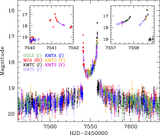OGLE-2016-BLG-1003: First Resolved Caustic-crossing Binary-source Event Discovered by Second-generation Microlensing Surveys
Abstract
We report the analysis of the first resolved caustic-crossing binary-source microlensing event OGLE-2016-BLG-1003. The event is densely covered by round-the-clock observations of three surveys. The light curve is characterized by two nested caustic-crossing features, which is unusual for typical caustic-crossing perturbations. From the modeling of the light curve, we find that the anomaly is produced by a binary source passing over a caustic formed by a binary lens. The result proves the importance of high-cadence and continuous observations, and the capability of second-generation microlensing experiments to identify such complex perturbations that are previously unknown. However, the result also raises the issues of the limitations of current analysis techniques for understanding lens systems beyond two masses and of determining the appropriate multiband observing strategy of survey experiments.
- Publication:
-
The Astrophysical Journal
- Pub Date:
- June 2017
- DOI:
- 10.3847/1538-4357/aa7057
- arXiv:
- arXiv:1705.01531
- Bibcode:
- 2017ApJ...841...75J
- Keywords:
-
- binaries: general;
- gravitational lensing: micro;
- Astrophysics - Solar and Stellar Astrophysics
- E-Print:
- 7 pages, 6 figures, Accepted for the publication in ApJ
